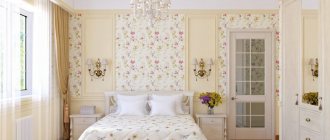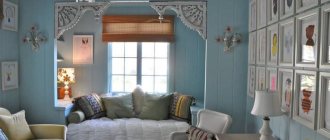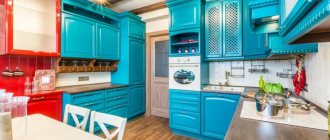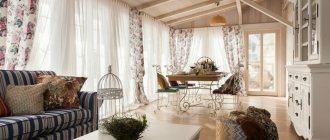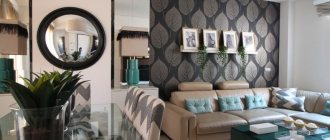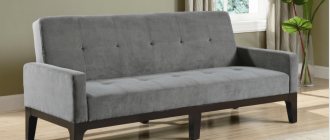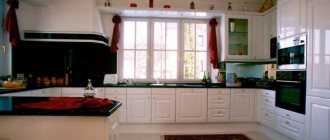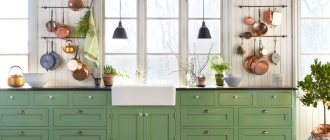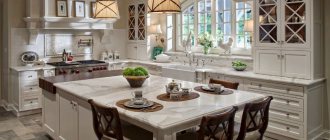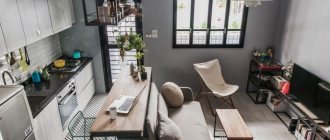Distinctive features of the Provencal style
Elements of Provence style in an apartment or house add a special piquancy to the interior.
Kitchen in Provence style
This style has distinctive features unique to it:
- Pastel shades. They must be warm.
- Natural materials. The design of a kitchen-living room in the Provence style should not contain elements like plastic. Wood, linen, cotton, stone are acceptable. At the same time, they must retain their texture.
- Aged furniture. This effect is achieved by fabrics imitating abrasions, wood carvings, etc.
- Floral motifs. Provence style means an abundance of flowers. It’s good if you can fill the house with living plants or herbariums, but the idea of floral motifs on curtains, furniture, tablecloths, etc. is also acceptable.
- Rustic decorative elements. These can be details made of ceramics or porcelain, knitted napkins, hand embroidery, ruffles, etc.
- Plaster on the walls.
- The ceiling is made of wooden beams.
- Forged elements, for example, a chandelier or candlesticks.
An important distinguishing feature is the abundance of light in the interior. Previously, this style was chosen only for dachas, but every year it becomes popular for apartments.
Features that distinguish Provence from other interior styles
Provence has its own characteristics that immediately distinguish it from other styles, therefore, in order not to violate the integrity of such a harmonious design, you need to know some subtleties that will help you correctly create a kitchen interior in a French restrained style.
- Delicate bed colors are the basis of Provence. They mainly use white, beige, light pink, blue, mint, lilac, and yellow colors. They help create a peaceful environment. Bright, rich colors in this interior can only be found as small decoration.
- Furniture, decoration and other interior elements should be made exclusively from natural materials. Stone and wood are mainly used in the kitchen.
- Small floral accents. Since this style should have notes of France, lilac, green or blue flowers will perfectly highlight the lavender and olive fields of Provence. Drawings, patterns, and flower patterns most often appear in the kitchen interior as decor for cabinet furniture or in the form of handmade embroidery on pillows, curtains, napkins, and tablecloths.
- The furniture should have a touch of antique style.
- Indoor live plants are welcome.
- It is better to refuse newfangled “bells and whistles”, so the necessary household appliances are built-in and hidden behind cabinet doors.
- The Provence style is not characterized by the presence of gloss, gilding, or sparkles.
Thanks to these simple rules, your kitchen, together with the combined living room, will be bright, exude a light, sophisticated French style and be conducive to easy work at the work surface and intimate conversations. For a family, this type of living room in Provence style will be the best option for coziness and comfort. Provence style is suitable for any room, both for a small apartment and a spacious house. The main thing is to follow all the above tips, since the slightest discrepancy will spoil the completeness of the interior in the French style.
Layout of the kitchen-living room in Provence style
Provençal style has no hard and fast rules. It is permissible to arrange furniture at your own discretion, based on tastes and convenience. The most popular kitchen layouts are:
- Corner. Allows you to increase the size of the work surface and get more usable space.
- U-shaped. It takes up a lot of space, but at the same time makes the kitchen as spacious as possible.
- Island. This is furniture that can be approached from any side. The optimal solution for a kitchen studio in a room with a medium to large area.
U-shaped kitchen in Provence style
To combine any layout with Provence style, you need to add distinctive features to it. If the kitchen is combined with the dining room, then a fireplace would be an excellent solution.
The color of the living room is Provence combined with the kitchen
The faded color scheme is just the result of good natural lighting from sunlight. But, of course, if you want to implement a design project in this style, you will have to imitate the “burnout” of surfaces. To do this, choose pastel shades for decorating walls and partly furniture. For example, natural wooden interior items, like forged metal parts, do not lose their color when exposed to direct sunlight, so they can be of a fairly rich tone. But paper wallpaper fades over time.
Therefore, the interior of the kitchen, as well as the adjacent living room, can be decorated in the following shades:
- White. The main color that can be safely called the most popular in the design of a kitchen space. Sparkling walls, furniture, accessories - everything can be just like that with just minor additions. But still, it cannot be called organic in the Provence style - white does not look “burnt out”, it is simply light in itself.
- Cream or pale yellow is one of the harmonious shades for kitchen decoration . This can be a plain finish - paint or plaster, or you can choose wallpaper with a barely noticeable pattern.
- Pastel green and blue are also suitable for decorating walls and painting furniture.
- Lavender is almost always present in the interior of a Provence style kitchen . This is the natural color of the surrounding houses in the French province of the same name - here villages are surrounded by lavender fields.
- The natural color of solid wood will remain unchanged if the wooden surfaces are not painted. It will emphasize the simplicity of design and create a favorable atmosphere.
- A natural palette of metal surfaces and forged parts is also present in the living room combined with the kitchen.
- Natural colors that would be appropriate in Provençal interiors include terracotta , a natural shade of clay. That is, bricks without painting, ceramic tiles for the floor and apron of the working area can be used here.
- Gray, used in any design direction, becomes a way to create the effect of constant lighting in a room. The living room and kitchen can be “flooded” with sunlight all the time thanks to the ash-colored design of certain areas of the room. This color imitates shadow, so it is suitable for this role in Provence decoration.
Since any room contains additional shades, the main tonality in this style will be complemented by a harmonious companion color. Moreover, it is needed for the organic zoning of a space in which there is a kitchen, a living room, and, possibly, a full-fledged dining room.
Interior zoning methods
In real life, the Provence style is often used in rooms where the kitchen, dining room and living room are interconnected. It's comfortable, but requires a special approach. The Provence style kitchen-living room should be divided into zones using additional elements. They may be:
- Arch. Installed at the entrance to each zone. A beautiful solution, but only suitable for houses with large areas and high ceilings. In other cases it will look bad.
- Partitions. They are a continuation of the wall, which protrudes quite a bit. Tempered glass elements or through shelving are often used for these purposes.
- Different decoration of the walls, floor and ceiling of the combined room. This can be a two-level floor, on the elevated part of which the kitchen work area is located. Also, different coating textures are often used on the floor, ceiling and walls.
- Furniture and interior items. Between the kitchen and the dining room you can install a buffet cabinet, a bar counter, or a dining table. It would be appropriate to separate the dining room from the living room with a sofa or fireplace. Aquariums, live plants or other decorative elements are often used for zoning.
Zoning the kitchen with the living room
The main task when zoning the space is to correctly combine all the elements. To understand for yourself how to do this, it is recommended to look at photographs in the Provence style.
Furniture selection
A kitchen in the Provencal style must be chosen according to certain rules so that it does not stand out from the overall interior, but harmoniously complements it. Since Provence is the style of the French village, furniture must obey the following rules:
- Kitchen colors can be pastel tones or light brown with elements of lavender or olive.
- The kitchen set needs to hide all household appliances as much as possible, given that this is a rustic, sophisticated style.
- You can choose a kitchen with either solid cabinets or glass inserts decorated with a pattern. The shelves are mostly closed, and decorative items are placed on the open ones. Kitchen fittings are made of bronze or copper.
- In the kitchen, it is appropriate to place an open display case with porcelain decorative plates in the middle. This decision is inspired by the Provence region of France.
The design of a kitchen or wooden living room furniture in the Provence style is characterized by elements of wear, as if a hint of aged, but no less valuable furniture.
Furniture here, in addition to its functional role, also plays a decorative role, especially for living rooms. In the living room they choose objects made from natural materials, mainly wood - ash, walnut, alder, oak. A living room in Provence style should not be filled with an abundance of furniture; the room should be bright, light, and spacious. A dining table of any shape is usually placed in the center of the living room. The color should be in harmony with the overall style and kitchen furniture. It is better to avoid wicker furniture in the apartment; it is more suitable for country premises. If space allows, you can place a chest of drawers, a display cabinet and a sofa. The sofa is also chosen in pastel colors with light pillows, on which neat small blue or lilac flowers can be embroidered.
Color palette
Colors in a provincial style are almost of primary importance. The basis is always white, milky, beige or cream. It is appropriate to add a richer sand shade, milk chocolate or ivory to them. This combination may seem boring to many, so it is permissible to dilute it with bright accents. But all bright colors should be in muted shades.
Acceptable colors are lavender, mint, turquoise, olive, lemon, etc. Such options can be used for wall coverings or on furniture. In the latter case, the interior will look more harmonious.
Choice of colors
The impression of a kitchen-living room in a provincial French style is largely determined by correctly selected colors. There are two types of shades involved in the design:
- Basic. For the color base, two or three light tones are chosen, reminiscent of the distant sultry coast, where the sun shines almost all year round. The basic palette includes white, milky, beige, and cream colors. They are complemented by shades of sand, milk chocolate and ivory.
In basic colors Source vip-1gl.ru
- Accents. The design cannot do without rich muted shades of lavender, mint, rose, and turquoise. Other rich colors are also suitable: blue, olive, lemon, sea green. The interior is enlivened by details of pistachio, terracotta, yellow and mustard colors.
Accent detail - olive walls Source 7nebo.kharkov.ua
Textiles and decor
This style is characterized by warmth and lightness. Textiles occupy a special place in it: curtains, tablecloths, napkins. But it is worth remembering a particular rule - textiles should be made exclusively from natural fabrics (cotton or linen). It would be appropriate to decorate it with embroidery, flounces and lace. In this case, only characteristic colors should be used.
The decor in the room can be either monochromatic or floral, checkered or vertical striped. To decorate your walls, you can purchase watercolor paintings of flowers or birds. They must be in a wooden frame. In the Provence style, special attention is paid to small details. Therefore, you can safely use different decor: flowers in pots, baskets, open shelves, jars for cereals and spices.
Textiles for Provencal style
Many people associate interior design in the Provence style with cozy country houses, but if you take into account all the nuances, this can be reproduced in an apartment.
Features of Provence style
Born in the southern French province, the interior assumes a simple setting - no frills, no pretentious decor. Due to the hot climate on the sea coast and the large number of sunny days, all surfaces in the rooms quickly lose their color - wallpaper and paint fade and become almost colorless.
Provence is French country, a rustic style, which, unlike other national trends, has the charm inherent in the French. The sophistication of aristocratic taste can be seen in every touch of this design.
Lighting
Lighting in provincial design should be very bright, thanks to which its elements will reveal themselves more effectively. For example, light green will be associated with freshly cut grass, and blue with the sea. This is what will make it possible to create the atmosphere of a French village.
It is a great advantage when bright lighting can be achieved naturally thanks to large windows, but this is often not possible. Therefore, chandeliers and lamps take on the main role. They should not be very small in size so that when entering the kitchen the eye stops on them.
To create lighting elements, you can use wire, ceramics, and crystal. The main advantage of such materials is maintaining the brightness of the lamps. For rooms with high ceilings, it is appropriate to choose chandeliers made of wood or forging, and if they are supplemented with lamps in the form of candles, this will not leave anyone indifferent.
Facing
To decorate a Provencal style floor, tiles or wood are used. Neither laminate nor linoleum are suitable for this, but if you cannot choose between the two options, you will have to settle on linoleum. The priority is unpainted wood, which is why you can choose a canvas with its imitation. You can also find wallpaper for plaster with a similar surface texture. As a last resort, you can take a closer look at wallpaper with imitation textiles.
For the walls of a combined room, it is better to choose cladding with the texture of untreated surfaces. However, sometimes you can get by with wallpaper, although their design will have to be selected with special care. You cannot overload the space with variegated flowers, otherwise it will lose its aesthetic appeal. If the walls are plain, and after combining the rooms there are still protrusions, they can be covered with wallpaper with a pale floral print.
The ideal ceiling is painted white, with beams or wooden slats. If they are not there, you can simply paint it with white paint. As a last resort, it is decorated using a stretch film with a matte texture and imitation of painted wood or plaster. If moldings are used to frame it, they should have an antique design, without gilding.
READ MORE: Jet band saws features of saws for metal, stone and wood Selecting a blade Operating instructions
Photo examples of kitchen-living room design in Provencal style
The best way to understand what the Provence style is is to take photos.
Kitchen-dining room
Vintage Provence
Characteristic decor for a kitchen in Provence style
Interior rich in decor
Characteristic textiles
Provence style is simplicity and luxury. It is an excellent option for decorating a kitchen both in a country house and in a metropolis apartment.
Furnishing the kitchen-living room
Comfort and harmony are two interrelated concepts, so it is important to select furniture that will organically fit into the composition of the chosen style and at the same time allow people to feel comfortable.
In the Provencal style, you should select several characteristic items for the kitchen-living room:
- Low upholstered furniture - without monograms and too lacy carvings, but with floral upholstery or plain upholstery, but in the color of the pattern on the wallpaper or other textile elements. As a rule, such models are chosen with a wooden frame.
- Vintage secretaries, sideboards, and cabinets will come in handy. These can be products of a classic design, but without gilding and excessive pomp. Symmetrical, elegant pieces of furniture with moldings or discreet carved patterns are suitable.
- A living room with a kitchen, combined with a dining room, in Provence style will be equipped with an elegant dining group. Chairs with a rounded back, which can be translucent due to wicker inserts, look harmonious. You can choose soft upholstery in the main color scheme of the room or in the color of discreet accents.
The amount of furniture depends entirely on the area of the room: you can achieve comfort and create a harmonious composition with the help of minimal furniture. But if the size of the room allows, you can choose organic chests of drawers for the living room, display cases, and bookcases.
Zone distribution options
When delimiting space, it is necessary to separate the kitchen and living room areas, but so that together they represent a single, holistic composition. For zoning, you can use one of the following ideas.
This option is only suitable for rooms with high ceilings.
Various flooring and wall finishes
Walls painted in different colors visually create the effect of two rooms. You can separate the kitchen and living room using a combination of two types of flooring, for example, tiles and wooden planks.
Fireplace
An interesting way of functional zoning is a fireplace, the façade of which is located in the living room. Dividers such as an aquarium or a hedge are also used.
Furniture
Zoning elements can be armchairs, a sofa, a shelving unit, a bar counter, or a dining table.
Sliding partition
The design of this piece of furniture should aesthetically fit into the overall appearance of the room.
Provence
Style Features
There are many nuances of interior design in this design style, but we can outline the main ones:
- soft pastel colors;
- an abundance of floral patterns wherever possible;
- light, not bulky furniture;
- furniture cannot be made in a factory, it must be specially ordered;
- most of the shelves in the sets are either open or glazed;
- furniture can be decorated with hand painting;
- very light floors;
- an abundance of indoor plants and bouquets of fresh and dried flowers;
- light curtains: either plain pastel or with floral print;
- ruffles, sewing, stitching, cutwork on all textiles;
- many kinds of decorative items: vases, small porcelain and ceramic figurines, textile dolls;
- light wooden ceiling with dark beams;
- the use of only natural materials (however, now it is also possible to use synthetic materials made to look like natural ones, but then this is no longer a style, but only stylization);
- the doors should be white, possibly with painted elements (flowers and leaves). The color combination in the interior is in pastel colors;
- window frames must be wooden;
- The windows are better big, and the curtains on them are small;
- the kitchen apron can be tiled, preferably painted with flowers or a very light solid color;
- massive lamps, if possible hanging on chains.
Advantages and disadvantages
The undeniable advantage of such interiors will be:
- abundance of light, pure home comfort;
- the opportunity to reveal your talents in creating and placing decorative details;
- You can constantly add new details, replace old ones (bouquets, plant arrangements, change textiles, and so on).
But there are also disadvantages:
- a full-fledged interior of this style cannot be created in a small space;
- Furniture can only be made to order; it cannot be bought in a store.
Combined with living room
Since it is difficult to create a full-fledged interior in the Provence style in small spaces, combining two rooms into one is a good solution.
And since the living room and kitchen are the main rooms in the apartment, in this case it turns out that almost the entire living space is made in the same style.
Techniques for combining kitchen and living room:
- the use of textiles with a repeating pattern in both rooms;
- the texture of the floor is the same, but the coating has different shades of the same color;
- kitchen and living room furniture in the same style;
- the walls in the kitchen are painted in pastel colors, the living room has wallpaper in the same shades with a floral print;
- one shape of flower pots,
- two or three identical vases in the kitchen and living room;
- lampshades of the same shape, texture and color, but different in size;
- ceilings painted in different shades of the same color.
Ways to visually separate the kitchen area and the living room area:
- ceiling beam, the same color as the furniture;
- instead of a beam, you can use a lambrequin made of fabric, the same as window curtains and other textiles, fixed to the ceiling on the line between the kitchen and living room;
- curtains along the line dividing two rooms. You can, after collecting them, secure them on a special hook in the wall with a bow or embroidered braid;
- An interesting technique: to mark the dividing line by placing two or three armchairs or a sofa with their backs facing the kitchen.
Small kitchen
It is almost impossible to create a full-fledged interior of a small kitchen in the Provence style, because furniture and decorative details take up quite a lot of space. But you can create an interior with elements of style.
In this case, it is necessary to take into account the following:
- the ceiling must certainly be white. Suspended plasterboard ceilings can be used;
- all furniture must be placed around the perimeter, in this case it is better to place the sink under the window, the furniture should be corner, with a large number of open shelves;
- the entire kitchen must be designed in one pastel tone;
- there must be a lot of light, and for this there are many small lamps;
- The window sill can be used as an additional work surface.
Now small kitchens with elements of Provence style have become very popular.
Color solutions
Provence does not tolerate too bright colors. These are muted, restrained, but very light shades. White and beige, milky, olive, lavender, sky blue and turquoise are actively used. Warm colors include light mustard, ocher, terracotta and pastel yellow. Marine shades and even accessories are in use: shells or fishing tackle. Sunny flowering meadows and the azure sea do not exclude, but harmoniously complement each other.
White living room in Provence style
White color and its variations are always the best choice for small living rooms that lack daylight. For the Provence style, white is completely native. Furniture looks especially expressive against the background of light walls, floors and ceilings. The texture of the wood appears even better and more clearly, and even the most delicate and pale shades become brighter and more expressive.
The real king of the white living room in the Provence style is bleached aged wood. It is suitable for flooring and furniture. And so that the elements do not merge into a solid mass, you can choose wood of different types and textures and dilute everything with original fittings and textiles.
Living room in Provence style in pastel colors
Pastel is another element of Provence. When choosing this color scheme for the living room, you need to take into account that the entire design should be soft, airy, and light. Provence always uses complex multi-component and diluted shades. Even white is more of an ivory or vanilla cream color. Cool gray-blue, romantic ash rose or warm powdery tones fit perfectly into the style.
Blue and lavender living room in Provence style
Sea blue and fragrant lavender are some of the defining characteristics of Provence. Lavender textiles with a rough texture look beautiful. And in a country house, you can safely paint even the window frame and shutters in an unusual color. Blue – delicate, blurry, not too saturated. It brings a feeling of pleasant coolness to the room. Muted turquoise looks good, and pale blue walls are one of the most common solutions.
Green living room in Provence style
Green shades are used mainly in textiles or to create accents. This is not a rich herbaceous or acidic salad, but rather a gentle olive. An interior based on natural materials and textures cannot do without one of the most natural colors. Green in Provence is a forest thicket, fragrant pine needles and vines. It is most actively used in floral patterns on walls, paintings, curtains, upholstery and pillows.
Living room in Provence style in bright colors
Although Provence does not tolerate too saturated and flashy colors, there is still a place for bright colors. Usually these are warm shades: mustard, terracotta, sunflower yellow, brick red. But such colors cannot be primary. They are used only to give the living room a little coziness, interesting color and warmth. These could be small accessories, pillows, floral painting.
Specifics of finishing work
Wall decor
The walls, typical for the interior of a living room in the Provence style, are a simple, roughly plastered surface of light colors, with deliberately created irregularities. The design is completed with various paintings, mirrors and other decorative components.
Ceiling finishing
In an individual residential building, a ceiling made of natural wood, slightly blackened by time or artificially aged, will be very advantageous.
For the ceiling in city apartments, it is advisable to use simply white or light paint in warm colors.
Flooring
A floor made of natural boards or laminated parquet that imitates wood will emphasize the originality of the Provençal style. Floor tiles with a characteristic pattern or stone will also fit perfectly into the style of the decor.
The living room furniture should meet the following points:
- Natural material;
- Light colors;
- Characteristic features of the decor: openwork metal, forged, gilded and painted elements;
- Natural fabrics.
A rocking chair and a fireplace are pleasant little things, not unconditional attributes.
Facade of a Provençal house
If you are the owner of your own country house or are just going to build it, you can initially set the accents. The first thing a guest sees is the facade of the building. It should be light, radiate an atmosphere of joy, warmth and sun.
Individual parts (windows, doors, etc.) are decorated in contrasting colors. This gives the house clarity and completeness.
Traditional finishing material in Provence - wild stone
In the design of a Provencal facade, combinations of several finishing materials are often used. For example, lining and wild stone can be harmoniously combined here.
The frames consist of narrow bindings. This allows you to reduce damage in case of accidental glass damage. To protect them, wooden shutters with elegant figured carvings are installed.
Patterned shutters provide window protection and additional decor.
There is a lantern hanging by the door. For the greatest resemblance to old France, you can choose a lamp that imitates a kerosene appliance of the 18th-19th centuries. Fans of the style install a massive forged lantern.
Stylized vintage lanterns are mounted next to the door
Style Basics
If you have a small room, then using white will help to visually expand the space and make the room more spacious and bright. Regardless of whether you use Provence style techniques in a country house or in an apartment, its details are slightly different.
So, if you have a private house, you can decorate the ceiling with wooden beams and ceilings. It's much easier to do this at home. In an apartment, you can simply paint the ceiling with a light shade of paint.
Along with the ceiling, the floor should also be decorated in the same style. This is a kind of basis for any interior and Provence is no exception. A laminate styled like wood would be most appropriate here. Natural wood is very difficult to maintain and will certainly lose its attractiveness over time. But laminate, when installed correctly, lasts a long time and does not cause any difficulties with maintenance.
A kitchen-living room in the Provence style is a kind of grandma’s attic, which, despite its apparent simplicity and even lack of thought, looks very stylish and modern.
